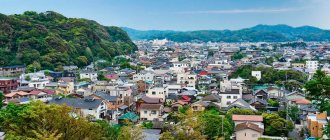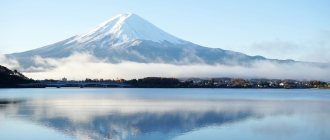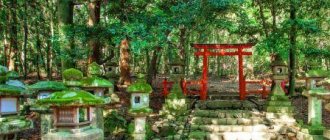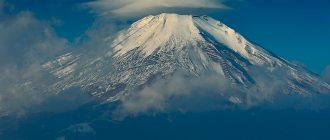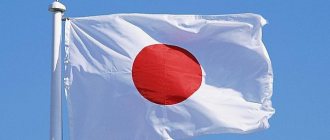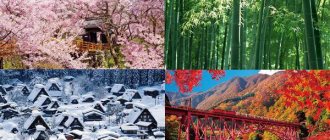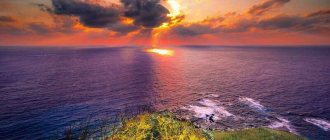Home page Natural phenomena
16 077 5 0
The ancient Japanese believed that only a true hero could climb Mount Fuji, and his reward for this would be immortality. Therefore, many residents of the Land of the Rising Sun are still convinced: the haze that is periodically visible above the mouth of the volcano is smoke from a fire that the gods lit with the help of the elixir of immortality.
Although the volcano was last active only three centuries ago, there is no mention of this event in any Japanese chronicle: local residents chose not to remember the wrath of the sacred mountain for a long time, and therefore, on a subconscious level, they consider Fuji a long-extinct volcano.
Description of Mount Fuji
Fuji is an active volcano located on the island of Honshu, just 90 km from the capital of the state, Tokyo. Its absolute height is 3776 meters above sea level. This is the highest peak in Japan.
The depth of the crater is approximately 200 meters, the width of the crater in diameter is 500 meters. The impressive size of the mountain has given rise to beautiful legends: Buddhists consider the crater to be a gateway to the other world, Shintoists claim that the top of the mountain connects two worlds, earthly and heavenly.
In Japanese translation, the name “Fujiyama” (Fuji, Fudshi-san) corresponds to the essence of the attraction and means “fire mountain”.
Mountaineering and tourism in Fuji
Today, Fuji is a place of pilgrimage and a popular tourist destination, attracting people from all over the world for its architectural and natural heritage. At the top of the mountain stands the Zionist temple Hongu Sengen, and around it lies the Fuji-Hakone-Izu National Park with five lakes, waterfalls and hot springs. For most of the year, the volcano is covered with a snow cap, but from the beginning of June to the end of August, the snow melts from its slopes, and mountaineering routes with rescue centers and mountain huts become available to tourists. Every year about 200 thousand mountaineering fans climb them, about 30% of whom are foreign guests.
Fuji Crater
History of Mount Fuji
Studying the map, scientists found that Mount Fuji is located on the line of the Pacific Ring of Fire. Directly below it is the junction of three lithospheric plates. This is the reason for the seismic activity of the area.
The history of the volcano begins approximately 80 thousand years ago. Active volcanoes constantly appeared at the site of tectonic faults. They erupted so often that they existed for only a few decades, collapsing from their own excessive activity: Sen-Komitake, Komitake, Old Fuji.
New Fuji, which attracts tourists today, was formed about 11 thousand years ago. Hot lava, constantly oozing from wide crevices, blocked the path of peacefully flowing rivers: this is how the Five Lakes were formed, which became one of the beauties of the local nature.
The Japanese have always treated the mountain as a sacred place. It was sung by poets; beautiful legends were created about its purpose and origin.
The largest volcano in Russia is Klyuchevsky
Kamchatka is home to a giant among Russian volcanoes. It is part of the Klyuchevskaya Sopka, on which 12 cone-shaped peaks rise. This is Klyuchevskoy volcano, whose height is 4 km 850 m. This is an old natural formation. Scientists believe that the volcano appeared about 7 thousand years ago.
It is noteworthy that the volcano was active quite recently, some two years ago. It was a beautiful and scary sight at the same time. The highest point of Kamchatka Mountain is at an altitude of 4850 meters. The highest active volcano in Russia, Klyuchevsky, has a unique summit crater with a diameter of almost half a kilometer. On it you can see the craters located on the sides, and the height of the location is very different. The fact that Klyuchevsky does not want to “rest” can be seen from the constantly rising columns of smoke and hot steam. The volcano constantly releases mixtures of various gases into the atmosphere. Living next to such a “noisy giant” is of course quite scary, so you can consider apartments in the Khimki area, the prices for which are quite acceptable. And the bulk of Kamchatka volcanoes are almost always active. An eruption begins every 5-6 years. Explosions follow one after another, bombs fly - rocks that are thrown to the surface with force. It looks beautiful from the outside! The craters open up and release hot lava from their womb. It is liquid, but at the same time, viscous. Rocks melt in it. Magma pours out through the crater. Lava, however, is not able to escape into the crater, it does not have enough strength, so it begins to look for a way out on the sides of the volcano, forming side craters.
For example, when the eruption occurred in 66 of the last century, many such side craters appeared. They were given names, calling the willows in honor of the famous scientist Boris Ivanovich Piip, who studies volcanoes. Now they are called Pip's breakthroughs. The highest volcano in Russia, starting to erupt, raises clouds of ash, which envelop everything around. Because of the gray cast, the sun is almost invisible; even on a sunny day it becomes as dark as at night. The last time the Klyuchevsky volcano “exploded” was in October 2013. The height of the ash column flying out of it initially reached 8 km 500 m. Later it increased to ten kilometers. The eruption was then in the southwest. Seismographs assigned the highest level of danger to the earthquake itself, which aviators call “red.” Klyuchevsky Volcano is the most active of all currently active Russian volcanoes. Already in the twenty-first century, five eruptions have been observed.
Eruptions
Volcano Fuji, which belongs to the type of volcanoes - dormant, but not extinct. The last time an eruption occurred was in 1707. It was a long, destructive process, provoked by an earthquake that occurred shortly before. Within two weeks, nearby villages were covered in ash. Agricultural lands were damaged, causing the death of the population from starvation. The city of Edo (modern Tokyo) was covered with a 15-centimeter layer of ash.
In total, over the long history of observations (since 718), 12 eruptions of Fuji have been recorded. It is worth special mentioning the following:
- 800 - as a result of volcanic activity, the road connecting Japanese settlements is filled with ash;
- 864 - the mountain erupted for two months. Lava buried nearby villages, and a flow of hot liquid divided Lake Senuomi into two others, smaller in size. The scorched earth could not recover for a long time: the forest at the site of the disaster was restored after a millennium.
More than three hundred years have passed since the last eruption, but Fuji is still dangerous: the mountain can awaken at any moment. Volcanologists tirelessly watch the dormant symbol of the Land of the Rising Sun: sometimes a light smoke appears above the crater, reminding people that the awakening of the monster is a very real prospect.
A few words about the classification of volcanoes
There are various classifications of volcanoes:
- If we consider the shape, we can distinguish thyroid, conical or dome-shaped natural formations.
- According to another classification, there are active, extinct, dormant or dormant.
In the Russian open spaces you can find any variety. It is known that these formations, when they begin to erupt, can cause death and destruction. Hot magma, carbon dioxide and ash fly out of the vent. A huge area is suffering. But at the same time, thanks to carbon dioxide emissions, the atmosphere around planet Earth is formed. Volcanoes located under water form the hydrosphere. Some scientists are of the opinion that volcanic activity contributes to the emergence of living beings in outer space. The most volcanoes are in South and Central America, Hawaii, Alaska, Iceland, the Atlantic, Kamchatka and the Kuril Islands. On the Kuril Islands alone there are 37 pieces. On Iturup Island today there are nine active volcanoes. There is nothing surprising here, since the islands themselves were formed as a result of an earthquake. There are not so many inhabitants in the Kuril Islands: about 18,000.
Interesting Facts
Like any attraction, Fuji amazes with an abundance of interesting facts related to its history, observations of scientists, and modern realities. Here are just a few of them:
- The top of the stratovolcano is covered with snow throughout the year.
- Officially, the symbol of Japan belongs to the Hongu Shinto Shrine.
- On the deadly mountain, in addition to the Hongu Temple, there is a post office and a meteorological station.
- The annual number of visitors to the volcano is over 200 thousand.
- The name of the volcano is believed to bring good luck in business: about a hundred Japanese companies use its name.
- The picturesque mountain, considered an example of grace, has never been captured by artists.
- The shape of the volcano is a cone with ideal proportions.
- Fuji helps you become luckier: just watch the sunrise at the temple located on the top of the volcano.
- Climbing the mountain allows you to admire the view from above. The permitted period for mountaineering is July, August.
- Fuji is the most attractive place for foreign tourists.
- On a clear day, the mountain is visible to residents of Tokyo.
- The first ascent of Mount Fuji occurred in 663: it was made by a Buddhist monk. The first European to do this was the British diplomat Rutherford Alcock in 1860.
The Japanese have long attached special importance to Fuji and treat the miracle of nature with reverence and respect. Foreign travelers arriving from the mainland consider it their duty to visit this dangerous, but at the same time incredibly beautiful mountain. Coming to Japan and ignoring the main symbol of the Land of the Rising Sun is an unforgivable omission.
Meaning in culture
The distinctive silhouette of a volcano, the top of which is covered with snow for most of the year, is a popular motif in art. The famous mountain landscapes are captured as woodcuts in two series under the same title: 36 Views of Mount Fuji (Hokusai), 36 Views of Mount Fuji (Hiroshige), were created separately by two artists named Hokusai Katsushika and Hiroshige Ando. Hokusai repeated this theme in an illustrated book published in three volumes entitled One Hundred Views of Mount Fuji between 1834 and 1849.
Fuji is also a sacred mountain for followers of Shintoism, as is the female deity Konohana no Sakuyahime no Mikoto.
It is considered one of the country's "three sacred mountains", along with Mount Tate and Mount Haku.
What will happen to Japan if Mount Fuji wakes up: the consequences of a possible eruption
If Mount Fuji becomes active, huge bursts of lava and ash will begin, which will be equal to the previous eruption, and maybe even larger. Between the capital and the cities of Nagoya, Osaka and the western part of the island of Japan, road traffic will be disrupted due to lava flows. The capital will be covered in an incredible layer of ash, which will damage buildings and other objects, and many residents will be in danger.
The American prophet said that after the eruption of this volcano, large-scale disasters will overtake the planet.
Climbing Fuji
Mount Fuji is a popular tourist destination in Japan and abroad. From July 1 to August 27, there are rescue centers and numerous yamagoya (山小屋, mountain hut) on the mountain, where you can buy food and drinks, as well as relax on sleeping shelves. Therefore, this period is considered the safest and most convenient for climbing. The rest of the time, the top of Fuji is covered with a thick layer of snow. Also, at the beginning of the season, some routes where there is still snow may be closed.
The mountain is divided into 10 levels, gome (Japanese: 合目). From level 5, gogome, there are 4 routes to the top: Kawaguchiko, Subashiri, Gotemba and Fujinomiya. There are also routes from the foot of the mountain: Shojiko, Yoshida, Suyama and Murayama.
From Lake Kawaguchiko to the 5th level, gogome, on the northern side (2300 m) there is a Subaru Line toll highway along which regular buses run. There is a large parking lot and many restaurants. Also along the route from gogome on the Kawaguchiko side there is the largest number of yamagoya. Most tourist tours go through it. The ascent from gogome to the top along any of the routes can take from three to eight hours (not counting the rest in yamagoya), the descent - from two to five hours.
In addition to the regular routes, there are parallel routes for bulldozers. Bulldozers deliver various goods and materials to Yamagoi and shops on the mountain top, and also evacuate people who need immediate medical attention. Using these routes is extremely dangerous, since they are not reinforced and are completely unprotected from stones that can roll down from above. Despite this, cyclists have been spotted descending these routes on several occasions. However, this can be dangerous both for the cyclist, due to the high steepness and speed, and for people climbing along the nearby walking routes, due to the stones that can bounce off from under the wheels.
Approximately 200,000 people visit Fuji each year, 30% of whom are foreigners.
Origin of the name
Even in our time, many scientists find it difficult to answer why Mount Fuji was given this name. Judging by modern hieroglyphs, “Fuji” literally means abundance and wealth. At the same time, we must not forget that the name has existed for many centuries, so such an approach will not be entirely correct and, most likely, does not have the correct semantic meaning. Many researchers refer to one of the Japanese chronicles dating back to the tenth century. It states that the name of the volcano means “immortality.”
One of the British missionaries (John Batchelor) already at the beginning of the twentieth century put forward a theory according to which the word “Fujiyama” is of Ainu origin and means a fire deity. However, the famous Japanese linguist Kyosuke later refuted this version. Research on this matter is still underway, but there is no single interpretation yet.
Part of the national park
As noted above, Mount Fuji is an integral part of the national park. On its slopes you can find many signs warning about a strict ban on throwing garbage. Moreover, before the ascent, each pilgrim receives a package intended for his collection, if one was left by someone. At the same time, no one considers it shameful to contribute to maintaining the Japanese shrine in a clean condition. To ensure proper order, there are also many automatic dry closets on the slopes.
LAVA FOR TOURIST
A volcanic eruption is certainly a beautiful and fascinating sight. But only if you are at a safe distance from the streams of molten lava rapidly rushing down the slopes. One can only sympathize with a person who finds himself at the foot of a fire-breathing mountain. It was in a similar situation that the residents of the island of Stromboli in Italy found themselves in mid-May of this year, when the volcano of the same name suddenly began to erupt. Black smoke rose from its mouth, fiery lava flowed through the crevices, and massive emissions of sand and ash covered the entire surface of the island. Fortunately, the eruption occurred in the spring, when there are not many tourists on the island yet. The spectators of such a beautiful and at the same time such a dangerous spectacle were mainly local residents.
The likelihood of negative behavior from Stromboli, which has been erupting with alarming regularity lately, is very high. Until May of this year, the volcano woke up on July 3, 2021 - then a 35-year-old tourist died and another lover of exotic beauty was injured. Volcanologists in Italy are seriously puzzled by the behavior of the volcano, saying that it has never shown such activity in its entire history. But the most unpleasant thing is that scientists expect massive volcanic activity this summer throughout the country, including the resort areas of Italy. Those wishing to visit the country must be very careful.
In confirmation of such forecasts, in February of this year, the Etna volcano in Sicily woke up, “delighting” local residents with stone rain and rivers of fiery lava flowing along its southeastern slope. The eruption was so strong that airports in Sicily temporarily stopped operating. It must be said that Etna has been causing worries for several years to volcanologists, who are literally knocked off their feet, trying to determine in which part of the mountain the next eruption will occur. The fact is that among scientists the Etna volcano received the nickname “the walking volcano.” It is gradually sliding into the Mediterranean Sea, and its surface is covered with cracks. Each of them can turn into a new crater with streams of fiery lava at any moment, causing many problems for both the indigenous residents and numerous tourists who love the local beauty.
